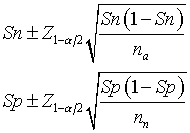
This page has moved to my new website.
Someone asked me how to determine the sample size for a study involving a diagnostic test. It seems like a tricky thing, because most studies of diagnostic tests don't have a formal hypothesis. What you need to do instead is to specify a particular statistic that you are interested in estimating and then selecting a sample size so that the confidence interval for this estimate is reasonably precise.
For example, suppose you want to estimate the sensitivity (Sn) and specificity (Sp) of a diagnostic test. Your best guess is that sensitivity will be at least 75% and specificity will be at least 90%. The formula for a confidence interval for Sn or Sp would be

where na and nn are the number of abnormal (diseased) and normal (healthy) patients in the study.
A sample of size 50 abnormal and 50 normal patients would give a95% confidence interval of plus/minus 0.12 for Sn and plus/minus 0.083 for Sp. This seems like a reasonable amount of precision. A sample of size 75 in each group would provide slightly narrower confidence intervals (plus/minus 0.098 and plus/minus 0.068 respectively). Your choice of the sample size depends in large part on the number of patients you can recruit from and also a balance between maximizing precision and minimizing the amount of time you spend on this project.
Suppose instead that you wanted to estimate the area under the curve (AUC) for a Received Operating Characteristic Curve (ROC curve). The formula for a standard error here is a bit messier. The web page
http://www.anaesthetist.com/mnm/stats/roc/
offers a JAVAScript calculator for the standard error of the AUC. Let's suppose that the AUC is going to be around 0.8. With the same 50 abnormal and normal patients, the standard error would be 0.044, which is reasonably small. With 75 in each group, the standard error would be 0.036.
I have a whole section on my web for determining the appropriate sample size, including a page on sample size for a diagnostic tests, which I have just updated to include the above example.